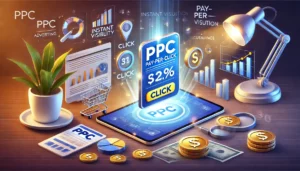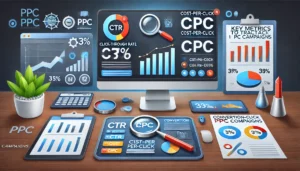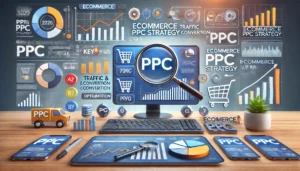Crafting a Winning Ecommerce PPC Strategy: A Step-by-Step Guide

Creating a successful PPC strategy for ecommerce can seem tricky, but it’s really about knowing the basics and making smart choices. This guide will walk you through each step to help you understand and build a winning PPC campaign for your online store.
Ecommerce PPC Strategy Key Takeaways
- Understand the basics of PPC and why it’s important for ecommerce businesses.
- Conduct thorough keyword research to find high-intent keywords that will attract the right audience.
- Create compelling ad copy that grabs attention and encourages clicks.
- Manage your PPC budget wisely to get the best return on investment.
- Continuously analyse and optimise your PPC campaigns to improve performance.
Understanding the Basics of Ecommerce PPC Strategy
Defining PPC and Its Importance
Pay-per-click (PPC) advertising is a model where advertisers pay a fee each time their ad is clicked. It’s a way to buy visits to your site, rather than earning them organically. For ecommerce businesses, PPC is crucial because it drives immediate traffic and can lead to quick sales. Instant visibility is one of the biggest advantages of PPC, making it a go-to strategy for many online stores.
How PPC Differs from SEO
While both PPC and SEO aim to increase visibility and traffic, they operate differently. SEO focuses on improving your site’s organic ranking through content and keywords, which can take time. PPC, on the other hand, offers instant results by placing your ads at the top of search results. This means you can start seeing traffic and sales almost immediately. However, unlike SEO, PPC requires a budget for each click.
Key Components of a PPC Campaign
A successful PPC campaign involves several key components:
- Keywords: Selecting the right keywords is essential. These are the terms your potential customers are searching for.
- Ad Copy: Crafting compelling ad copy that grabs attention and encourages clicks.
- Landing Pages: Ensuring your landing pages are relevant to the ad and provide a seamless user experience.
- Budget: Setting a budget that aligns with your business goals and allows for effective bidding.
- Analytics: Using tools to track performance and make data-driven decisions.
Understanding these basics sets the foundation for a winning ecommerce PPC strategy. With the right approach, you can drive targeted traffic and boost your sales quickly.
By mastering these elements, we can create a robust PPC strategy that not only attracts visitors but also converts them into customers. Whether you’re working with a PPC ecommerce agency or managing campaigns in-house, these fundamentals are key to success.
Conducting Thorough Keyword Research
Tools for Effective Keyword Research
To kick off our keyword research, we need the right tools. Google Keyword Planner and SEMrush are excellent starting points. These tools help us identify search volume, cost-per-click, and competitive density. Using these tools effectively can make a huge difference in our campaigns.
Identifying High-Intent Keywords
High-intent keywords are crucial for driving conversions. These keywords can be transactional, informational, or navigational. For example, a transactional keyword might be “buy running shoes online.” We should focus on these to attract users ready to make a purchase.
Balancing Short-Tail and Long-Tail Keywords
Balancing short-tail and long-tail keywords is essential. Short-tail keywords are broad and have high search volumes, like “running shoes.” Long-tail keywords are more specific, such as “best running shoes for flat feet.” Using a mix of both can help us reach a wider audience while also targeting specific needs.
Remember, thorough keyword research is the foundation of a successful PPC campaign. It helps us reach the right audience and drive conversions effectively.
Creating Compelling Ad Copy (Ecommerce PPC Strategy)
Writing Attention-Grabbing Headlines
Crafting headlines that grab attention is crucial. We need to ensure our headlines are not only catchy but also relevant to our audience. A good headline should communicate the offer clearly and entice the reader to click. Remember, the headline is the first thing users see.
Crafting Persuasive Ad Descriptions
Ad descriptions should be concise yet persuasive. They need to highlight the benefits of our product or service and include a clear call to action. By focusing on what sets our offer apart, we can make our ads more appealing. It’s essential to use high-intent keywords to attract the right audience.
Utilising Ad Extensions for Better Visibility
Ad extensions can significantly improve the visibility of our ads. They provide additional information and can include links to specific pages on our website. Using ad extensions effectively can lead to higher click-through rates and better conversion tracking. We should regularly review and update our ad extensions to ensure they remain relevant and useful.
Consistently updating and testing our ad copy is key to maintaining high performance in our PPC campaigns.
Setting Up and Managing Your PPC Budget
Determining Your Initial Budget
Setting an initial budget is crucial for the success of your PPC campaigns. We need to ensure that our budget isn’t too low, as this can prevent our campaigns from gaining the necessary traction. On the other hand, we must avoid overspending. Finding the right balance is key. We recommend starting with a modest budget and gradually increasing it as we see positive results.
Allocating Funds Across Campaigns
Once we have our initial budget, the next step is to allocate funds across different campaigns. For instance, a shopping campaign might be ideal for eCommerce sales, while display campaigns can help build brand awareness. It’s important to be flexible and adjust our allocations based on performance data.
Monitoring and Adjusting Spend
Monitoring our spend is essential to ensure we are getting the best return on investment (ROI). We should regularly review key metrics such as click-through rate (CTR), cost per click (CPC), and conversion rate. If we notice that a campaign is underperforming, we need to make adjustments. This could involve reallocating funds or tweaking ad copy and targeting options.
It’s important to give any optimisations or set-ups ample time to collect the necessary data before making significant changes.
By following these steps, we can effectively manage our PPC budget and maximise our advertising performance.
Designing High-Converting Landing Pages
Ensuring Consistency Between Ads and Landing Pages
When users click on an ad, they expect to find information that matches the ad’s promise. Ensuring that your landing page is consistent with your ad copy is crucial. This means using similar keywords, images, and offers. If your ad promotes a discount on running shoes, the landing page should prominently feature those shoes and the discount. This consistency helps reduce bounce rates and increases the likelihood of conversions.
Optimising for Mobile Users (Ecommerce PPC Strategy)
With more people using mobile devices to browse and shop online, it’s essential to optimise your landing pages for mobile users. A mobile-friendly design ensures that your page loads quickly and is easy to navigate on smaller screens. Use responsive design techniques to make sure your content adjusts to different screen sizes. A seamless mobile experience can significantly boost your conversion rates.
A/B Testing for Best Results
A/B testing involves creating two versions of a landing page and seeing which one performs better. This can help you understand what elements resonate most with your audience. Test different headlines, images, calls to action, and layouts. By continually refining your landing pages based on A/B test results, you can improve their effectiveness over time.
Remember, a well-designed landing page is key to converting visitors into customers. It should be visually appealing, relevant to the ad content, and contain a clear call to action.
By focusing on these aspects, we can create landing pages that not only attract visitors but also convert them into loyal customers.
Implementing Effective Bidding Strategies
Manual vs. Automated Bidding
When it comes to bidding strategies, we have two main options: manual and automated. Manual bidding gives us full control over our bids, allowing us to adjust them based on performance. However, it can be time-consuming. Automated bidding, on the other hand, uses algorithms to set bids for us, aiming to maximise results based on our goals. Choosing the right strategy depends on our specific needs and resources.
Understanding Cost-Per-Click (CPC)
Cost-Per-Click (CPC) is a crucial metric in PPC campaigns. It tells us how much we pay each time someone clicks on our ad. Lowering our CPC can help us get more clicks for the same budget. We can achieve this by improving our ad quality and relevance. Using tools like the [Google Ads Keyword Planner](https://www.google.com/ads/keyword-planner) can provide insights into keyword costs and help us manage our bids effectively.
Adjusting Bids Based on Performance
Monitoring and adjusting bids based on performance is essential for a successful PPC campaign. We should regularly review our campaign data to identify which keywords and ads are performing well and which are not. By increasing bids on high-performing keywords and reducing them on underperforming ones, we can optimise our budget and improve our return on investment (ROI).
Effective bidding strategies are key to maximising the success of our PPC campaigns. By understanding the nuances of manual and automated bidding, keeping an eye on CPC, and adjusting bids based on performance, we can ensure our ads are both cost-effective and impactful.
Utilising Advanced Targeting Options
Demographic Targeting
Demographic targeting allows us to reach specific groups based on age, gender, income, and more. By understanding our audience’s demographics, we can tailor our ads to better meet their needs. This ensures our ads are more relevant and engaging.
Geographic Targeting
Geographic targeting focuses on showing ads to users in specific locations. Whether it’s a country, city, or even a neighbourhood, this method helps us reach potential customers where they are most likely to convert. Local businesses benefit greatly from this approach.
Behavioural Targeting
Behavioural targeting uses data on users’ past behaviours, such as browsing history and previous purchases, to show them relevant ads. This strategy helps keep our brand top of mind and encourages repeat business. By leveraging this data, we can create highly personalised ad experiences.
Leveraging Retargeting Campaigns: Ecommerce PPC Strategy
Setting Up Retargeting Pixels
To start with retargeting, we need to set up retargeting pixels on our website. These small pieces of code track visitors and their actions. By doing this, we can gather valuable data on user behaviour. This data helps us create more targeted ads, ensuring our brand stays top-of-mind for potential customers.
Creating Custom Audiences
Once we have the data, we can create custom audiences. These audiences are groups of users who have shown interest in our products but haven’t made a purchase yet. By targeting these groups with specific ads, we can encourage them to return and complete their purchase. This strategy significantly increases conversion rates.
Measuring Retargeting Success
It’s crucial to measure the success of our retargeting campaigns. We should track key metrics like click-through rates (CTR), conversion rates, and return on ad spend (ROAS). By analysing these metrics, we can make data-driven decisions to optimise our campaigns. This continuous improvement process ensures we get the most out of our retargeting efforts.
Retargeting is a powerful tool in our ecommerce PPC strategy. It helps us recapture the attention of visitors who left our site without buying, significantly boosting our conversion rates.
By leveraging retargeting campaigns, we can get more traffic to your company website and drive more sales. This approach not only increases our visibility but also builds trust with our target customers, encouraging them to choose our brand over competitors.
Analysing and Optimising Campaign Performance
Key Metrics to Track
To make sure our PPC campaigns are successful, we need to keep an eye on several key metrics. These include:
- Click-Through Rate (CTR): This tells us how many people are clicking on our ads. If it’s going up, that’s a good sign.
- Cost-Per-Click (CPC): This shows how much we’re paying for each click. Lower is better.
- Conversion Rate: This measures how many clicks turn into sales or leads. If it’s low, we might need to tweak our landing page.
Using Analytics Tools
We can use various tools to help us track these metrics. Google Analytics and other platforms provide detailed reports. These tools help us see what’s working and what needs improvement.
Making Data-Driven Decisions
By looking at the data, we can make smart choices about our campaigns. For example, if a certain keyword is performing well, we might want to allocate more budget to it. On the other hand, if a keyword isn’t doing well, we can reduce its budget or try different ad copy.
Continually tweaking our PPC ads and optimising them and our landing page are the keys to a successful campaign that will get us results.
Regularly reviewing and adjusting our campaigns ensures we get the best return on our investment. This is where a Google ads audit can be very helpful. It can show us areas for improvement and help us get the most out of our budget.
Exploring Different PPC Platforms: Ecommerce PPC Strategy
Google Ads for Ecommerce
When it comes to ecommerce, Google Ads is often the go-to platform. It offers a variety of ad formats, including text ads, shopping ads, and display ads. Google Ads allows us to target users based on their search queries, making it easier to reach potential customers who are actively looking for products like ours. Additionally, Google Ads provides detailed analytics, helping us to fine-tune our campaigns for better performance.
Bing Ads and Its Benefits
Bing Ads, now known as Microsoft Advertising, is another powerful platform for ecommerce. While it may not have the same reach as Google Ads, it often has lower competition and cost-per-click (CPC). This can make it a cost-effective option for businesses looking to maximise their return on investment. Bing Ads also integrates well with LinkedIn, allowing for advanced targeting options.
Social Media PPC Options
Social media platforms like Facebook, Instagram, and Pinterest offer unique opportunities for ecommerce businesses. These platforms allow us to target users based on their interests, behaviours, and demographics. For instance, Facebook Ads can be highly effective due to its vast user base and advanced targeting capabilities. Instagram Ads are great for visually appealing products, while Pinterest Ads can drive high-intent traffic to our site.
Choosing the right PPC platform depends on our specific goals and target audience. It’s essential to experiment with different platforms to find the best fit for our business.
In summary, each PPC platform has its own strengths and weaknesses. By understanding these, we can make informed decisions and craft a winning ecommerce PPC strategy.
Staying Updated with PPC Trends and Best Practises
Following Industry Blogs and Forums
To stay ahead in the PPC game, we must follow industry blogs and forums. These platforms are treasure troves of the latest trends, tips, and best practices. By regularly reading posts and participating in discussions, we can gain insights that help us refine our strategies. Staying informed is crucial for adapting to changes and maintaining a competitive edge.
Attending Webinars and Conferences (Ecommerce PPC Strategy)
Webinars and conferences are excellent opportunities to learn from experts and network with peers. They often feature sessions on the latest tools, techniques, and case studies. By attending these events, we can gather valuable knowledge and apply it to our campaigns. Plus, they provide a platform to ask questions and get answers from industry leaders.
Continuous Learning and Adaptation
The PPC landscape is ever-evolving, and continuous learning is essential. We should invest time in online courses, certifications, and training programmes. This not only enhances our skills but also keeps us updated with the latest advancements. Adaptation is key; by staying flexible and open to new ideas, we can ensure our strategies remain effective.
The PPC Geeks specialise in rigorous, data-driven ad copy testing to optimise Google Ads and PPC campaigns. They offer services for ecommerce marketing, Amazon ads, and SEM, ensuring businesses achieve their marketing objectives.
Keeping up with the latest PPC trends and best practices is crucial for staying ahead in the digital marketing game. Our team at PPC Geeks is dedicated to helping you navigate these changes and optimise your campaigns for maximum results. Don’t miss out on the opportunity to boost your brand’s performance. Visit our website today for a free, expert review of your ads.
Conclusion Ecommerce PPC Strategy
Creating a successful ecommerce PPC strategy is more than just setting up ads and hoping for the best. It requires careful planning, continuous monitoring, and a willingness to adapt. By following the steps outlined in this guide, you can develop a PPC campaign that not only drives traffic but also converts visitors into loyal customers. Remember, the key to a winning strategy lies in understanding your audience, selecting the right keywords, and optimising your ads and landing pages. With dedication and the right approach, your ecommerce business can achieve remarkable growth through PPC advertising.
Ecommerce PPC Strategy: Frequently Asked Questions
What is PPC and why is it important for ecommerce?
PPC stands for Pay-Per-Click. It’s a type of online advertising where you pay each time someone clicks on your ad. It’s important for ecommerce because it helps drive targeted traffic to your website quickly.
How is PPC different from SEO?
PPC involves paying for ads to appear in search results, while SEO (Search Engine Optimisation) focuses on improving your website so it appears organically in search results. PPC can bring immediate traffic, whereas SEO is a long-term strategy.
What are the key parts of a PPC campaign?
A PPC campaign includes keyword research, creating ads, setting a budget, and monitoring performance. Each part is crucial for the success of the campaign.
How do I find the right keywords for my PPC campaign?
You can use tools like Google Keyword Planner or SEMrush to find keywords. Look for high-intent keywords that potential customers are likely to use when they’re ready to buy.
How should I set my PPC budget?
Start by determining how much you’re willing to spend overall. Then, allocate your budget across different campaigns and adjust based on performance. Keep an eye on your spending to make sure you’re getting good returns.
What makes a good ad copy for PPC?
A good ad copy grabs attention with a strong headline, includes a clear call-to-action, and highlights what makes your product or service unique. Using ad extensions can also improve visibility.
Why are landing pages important in PPC?
Landing pages are where users go after clicking your ad. They should match the ad’s message and be designed to convert visitors into customers. Consistent and optimised landing pages improve campaign success.
What is retargeting in PPC?
Retargeting shows ads to people who have already visited your website. It helps keep your brand in mind and encourages visitors to return and make a purchase.
Author
Search Blog
Free PPC Audit
Subscribe to our Newsletter
The Voices of Our Success: Your Words, Our Pride
Don't just take our word for it. With over 100+ five-star reviews, we let our work-and our satisfied clients-speak for us.
"We have been working with PPC Geeks for around 6 months and have found Mark and the team to be very impressive. Having worked with a few companies in this and similar sectors, I rate PPC Geeks as the strongest I have come across. They have taken time to understand our business, our market and competitors and supported us to devise a strategy to generate business. I value the expertise Mark and his team provide and trust them to make the best recommendations for the long-term."
~ Just Go, Alasdair Anderson




